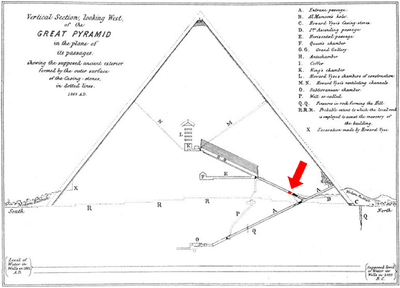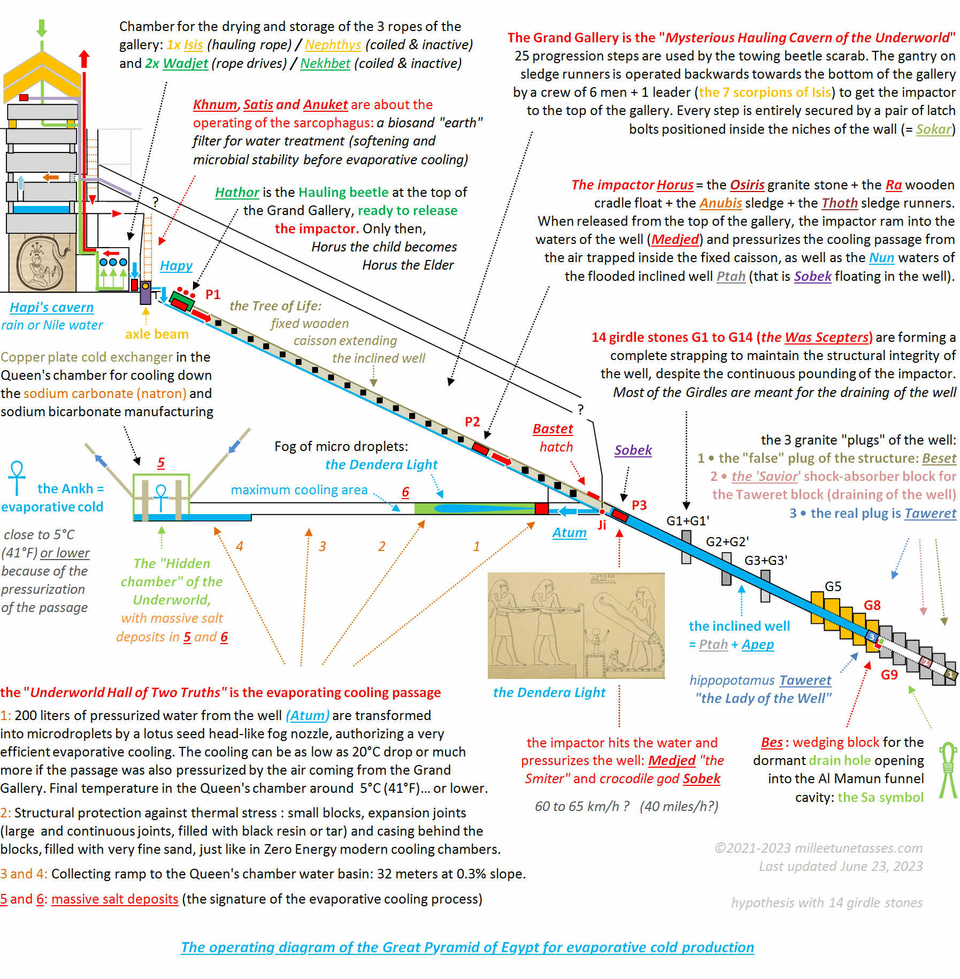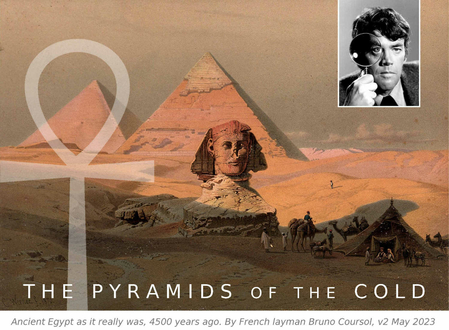- Retour accueil
- Vous êtes ici : Blog The Pyramids of the Cold v2 The Pyramids of the Cold Section 7 • The Taweret Lady of the Well temporary sealing plug
The Pyramids of the Cold Section 7 • The Taweret Lady of the Well temporary sealing plug
Publié par Bruno Coursol dans The Pyramids of the Cold v2 le 13/05/2023 à 19:25

Photograph of the upper granite plug of the Great Pyramid of Egypt : "Great Pyramid Passages, Volume 1, by John and Morton Edgar, 1910" page 173 : https://archive.org/details/GreatPyramidPassagesVol11910Edition/page/n181/mode/2up (damaged reproduction). Full image at: https://commons.wikimedia.org/wiki/File:49_edgar.jpg
The Pyramids of the Cold v2 (May 2023) - Part B • The inclined well of the Great Pyramid
Section 7 • The Taweret Lady of the Well sealing block

In summary: goddess of Childbirth Taweret is a glorifying metaphoric representation of the upper granite plug of the Great Pyramid of Giza. Because Taweret is referring to the granite block that was the sealing block at the bottom of the inclined well, and would have been permanently underwater, Taweret had been personified into an hippopotamus : a huge semiaquatic animal that loves to stay, walk and even sleep completely submerged underwater.
Some of Taweret's epithets are "the Lady of the Well", and "She Who Removes Water".
Taweret and Bes (the wedging block that maintained Taweret in place during the operation period of the pyramid) were associated with chilbirth, because of the way these two blocks were involved into the draining procedure of the well through a drain hole : the metaphor is about the water breaking.

Hatshepsut’s birth scene, from Édouard Naville "The Temple of Deir el Bahari" (London, 1896), vol. 2, pl. 50. Image courtesy of the University Library Heidelberg: The Ebony shrine, northern half of the middle platform. https://digi.ub.uni-heidelberg.de/diglit/naville1896bd2/0050
7.01 The Hatshepsut’s birth scene, from Édouard Naville "The Temple of Deir el Bahari"
I really didn't expect to find any kind of proof that would validate the fact that the Taweret block was maintained in its position for the time being of the operating of the Great Pyramid, by a wedging block , but not only the immobilized Taweret/Bes scene is that proof and Bes that particular wedging block, but also we have to note the position of that scene within the entire relief: it is located at the very end of the story.
Whatever the story is exactly, the scene showing that Taweret was blocked by Bes is at the very end of it.
We can imagine 2 different approaches :
1 • Time related approach: the story ends up when it is time for Bes to break and stop immobilizing Taweret. It would be the end of the operating period of the pyramid.
2 • Space related approach: this is a plan of the entire ascending passage that starts with the Grand Gallery and the 4 crewmembers of one hauling beetle, and end with the Taweret/Bes couple at the bottom of the flooded part of the first ascending passage, the inclined well.
Between the 4 crewmembers and the Taweret/Bes couple, there is a bizarre empty space, but again it can be interpreted with both approaches: time and space related.

Original draw of the internal layout of the Great Pyramid of Egypt at Giza: https://commons.wikimedia.org/wiki/File:The_Secret_Teaching_of_All_Ages_-_Chapter_6_-_Pyramid.jpg
7.02 The original postion of the upper granite plug in the ascending passage
The original position of the upper granite plug of the Great Pyramid of Egypt was not so far from where it is resting today. This block has been glorified into the hippopotamus goddess Taweret, who was called "the Great One" and "the One who releases the water".

7.03 The immobilization of goddess Taweret "the Big One", the "Lady of the Well", by the wedging block Bes in his unmovable posture
Operating diagram of the inclined well of the Great Pyramid of Egypt at Giza.

Hatshepsut’s birth scene, from Édouard Naville "The Temple of Deir el Bahari" (London, 1896), vol. 2, pl. 50. Image courtesy of the University Library Heidelberg: The Ebony shrine, northern half of the middle platform. https://digi.ub.uni-heidelberg.de/diglit/naville1896bd2/0050
7.04 The immobilization of goddess Taweret "the Big One", the "Lady of the Well", by the wedging block Bes in his unmovable posture
The ancient Egyptian glorifying representation of the Bes and Taweret positions and operation in the inclined well of the Great Pyramid.

The inclined well of the Great Pyramid of Giza, during its operation period, showing the Taweret granite sealing block and the small Bes granite wedging block.
7.05 Taweret "the Great One" who "removes water" and the water breaking metaphor
The draining of the inclined well would have result in a huge amount of water gushing out of the bottom of the well after the upper granite plug had moved down and revealed the breach. The metaphor with the water breaking is the origin of the Taweret goddess of childbirth.
"In Ancient Egyptian religion, Taweret is the protective ancient Egyptian goddess of childbirth and fertility. The deity is typically depicted as a bipedal female hippopotamus with feline attributes, pendulous female human breasts, the limbs and paws of a lion, and the back and tail of a Nile crocodile.[...] She commonly bears the epithets "Lady of Heaven", "Mistress of the Horizon", "She Who Removes Water", "Mistress of Pure Water", and "Lady of the Birth House" [...]
The name "Taweret" (Tȝ-wrt) means "she who is great" or simply "great one". Source: https://en.wikipedia.org/wiki/Taweret
As clearly said by Anneke Stracke in her thesis "The Hippopotamus of Deir el-Medina", goddess Taweret was clearly associated with water:
Excerpt from page 30 of her thesis: "Of the twelve objects within this catalogue that include hieroglyphic epithets of Taweret… three of them make clear mention of her role as a goddess of water. While it is not unthinkable that a hippopotamus goddess should be associated with water, it is still quite unusual that a quarter of all epithets of the goddess which survive from Deir el-Medina feature this role so heavily. The epithets preserved in Deir el-Medina refer to “the pure water”, “lady of the well” and “Taweret, who is in the midst of the purification waters of Nun”. https://studenttheses.universiteitleiden.nl/access/item%3A2624829/view
In short, some of Taweret's epithets are: "the Lady of the Well", "the Big One", "the Great One" and "She Who Removes Water", and she is referring to the upper granite plug (block #3).
In other words, Taweret is the upper granite plug: "The Great One", "The Big One", "The Lady of the Well" and "The One Who Removes Water".
The fact that both Bes and Taweret, as the wedging block and the sealing of the well block, were both associated with the draining of the well, explains why both were associated with childbirth: the metaphor is about the water breaking.

Original of the Diagram of the First Ascending Passage, by John and Morton Edgar, in "Great Pyramid Passages", 1910 , plate CX, paragraph ref. 460, page 230: archive.org/details/GreatPyramidPassagesVol11910Edition/page/n239/mode/2up
7.06 The structure and layout of the ascending passage
The ascending passage of the Great Pyramid of Giza showing the little imprint with a small block of granite still present today and that was the anchor for the Bes wedging block.

Left: the cavity of the Caliph Al-Ma'mun, in which the water of the inclined well (the ascending passage of the Great Pyramid of Khufu) was drained into. The upper granite plug has been deified into goddess Taweret: "the Lady of the Well", the "Big One", the "Great One" and "She Who Removes Water". Photograph of the cavity of Al-Ma'mun in "Great Pyramid Passages, Volume 1, by John and Morton Edgar, 1910": Plate LXIV, page 166: https://archive.org/details/GreatPyramidPassagesVol11910Edition/page/n174/mode/1up
Right:John Edgar looking at the Taweret block. "Besides these photographs of the lower end of the Granite Plug, I developed a number - which had been taken at the upper end. One shows John stooping in the First Ascending Passage, and leaning with his right-hand on the fractured upper end of the Plug— Plate LXIX." Morton Edgar, 22nd June 1909.
Photograph of the upper granite plug of the Great Pyramid of Egypt: "Great Pyramid Passages, Volume 1, by John and Morton Edgar, 1910" page 173: https://archive.org/details/GreatPyramidPassagesVol11910Edition/page/n181/mode/2up (damaged reproduction). Full image at: https://commons.wikimedia.org/wiki/File:49_edgar.jpg

wikimedia.org/wiki/File:Hippopotamus_amphibius_-San_Diego_Zoo,_California,_USA_-under_water-8a.jpg
7.07 Why goddess Taweret is represented as an hippopotamus
When the Great Pyramid was operational and the ascending passage flooded to form an inclined well, in the continuation of the Grand Gallery's central gutter, the upper granite plug was sealing the well.
Consequently, this sealing block would have been permanently underwater : it explains why ancient Egyptians chose to personify this block into the hippopotamus: a huge semiaquatic animal that loves to stay, walk and even sleep completely submerged underwater.

Taweret giving birth to snakes = Taweret giving birth to water (the water breaking metaphor).
Amulet of the Goddess Taweret 48.1555 from the Walters Art Museum, Baltimore: https://art.thewalters.org/detail/11051/amulet-pendant-of-taweret/
Blue glazed steatite figure of Taweret and a snake EA11862 from the British Museum: https://www.britishmuseum.org/collection/object/Y_EA11862
7.08 Taweret: the "Lady of the Well" and "She who Removes water"
EA11862 from the British Museum is a very unusual figure that is depicting Taweret "giving birth" to a snake. To my knowledge, this is the only representation of Taweret associated with a snake.
We've seen in the previous post that snakes in ancient Egypt, were representations of the water from the annual inundation of the Nile: the very first snake is created by Hapi himself (relief of the Philae temple).
Here, with Taweret, we have the representation of the "last" snake, so to speak: Taweret is the representation of the draining of the inclined well that preceded the final shutdown procedure of the Great Pyramid.
Another outstanding figure of Taweret is the amulet 48.1555 from the Walters Art Museum, in Baltimore: it is the only figurine I know of Taweret that is revealing that the Sa sign is actually set on the figure so it is hiding from view a "secret pouring hole".

The upper granite plug of the Great Pyramid of Giza was the sealing block of the inclined well. This block had been glorified into the "Lady of the Well" Taweret goddess and represented into the hippopotamus, a huge semiaquatic animal that loves to stay, walk and even sleep completely submerged underwater.
7.09 The completely worn out upper granite plug is Taweret: the "Lady of the Well"
If you compare the two blocks appearing on the above photograph from the Edgar brothers, you can immediately see that if the lower block (this is the middle plug #2) looks like new, this is not true for the upper block that appears completely worn out.
Also its upper face looks curved, like something was stuck to it, but maybe this is only an illusion.
This Taweret block had a story completely different from the other granite plugs. The only logical explanation about the fact it appears so worn out, is that this block, and only this one, did moved or should I say forced its passage, on a short distance. It only could have been on a short distance, because many Egyptologists said that farther away up, the dimensions of the ascending passage wouldn't allow the block to pass through.
It is important to say that this upper block #3 would have only move a few meters and that it would have been most probably forced to do it by the huge pressure caused by the "explosive" opening of the King's chamber : if I am right about this, the man inside the grotto, not only triggered the last release of the impactor, but the impactor itself triggered the opening of the chamber.

The emblem that Taweret is wearing on her head is the wedging block that maintained her into position before the draining of the well procedure. That emblem is Bes, the wedging block of the well.
Accession Number: 26.7.1193 from the Metropolitan Museum in New York : https://www.metmuseum.org/art/collection/search/544864
Glencairn Museum's Taweret figurine E66. Late Period: https://glencairnmuseum.org/newsletter/september-2014-the-goddess-taweret-protector-of-mothers-and.html
Faience Statuette of Taweret Ref.1352 from Christoph Bacher Archäologie Ancient Art, Vienna: https://www.cb-gallery.com/en/produkt/fayence-statuette-der-taweret/
Artemis Gallery, Louisville CO: https://www.bidsquare.com/online-auctions/artemis-gallery/impressive-detailed-egyptian-faience-votive---taweret-1396924
7.10 The small granite block that was set in the floor imprint between the G8 and G9 girdle stones
In my opinion, the emblem that is showing Taweret on her head is the granite wedging block that was set on the floor of the ascending passage/inclined well, right between the G8 and G9 girdles.
Academic explanation is that this emblem is probably a "mast" that would have been needed to put a special headdress. But if you look at the last above photograph of a Taweret figure from the Artemis Gallery, in Louisville (CO), the "mast" is way to tiny to do the job. This cannot be a supporting "mast".
More about the Bes wedging block in the next Section.

Diagram of the operating Great Pyramid of Egypt for evaporative cold production (hypothetically for chemical manufacturing cooling of pure sodium carbonate "natron", the salt used for the mummification of pharaohs). When in operation, the elevation of the Great Pyramid was not finished, and it is only after the shutdown procedure and the draining of the inclined well, that the 3 granite plugs were finally close to one another.

The Pyramids of the Cold version 2 (May 2023 - May 2024)
Summary of the study and Table of Contents
Part A: The evaporative cooling process
Section 1 • The horizontal evaporative cooling passage layout
Section 2 • The Dendera Light and the creation of the fog of microdroplets by the fog nozzle
Section 3 • The water cycle glorifying metaphors: Geb, Shu, Nut, Tefnut
Section 4 • The theorization of the evaporative cooling process by Akhenaten and Nefertiti
Section 5 • The theorization of the evaporative cooling process in the Weighing of the Heart
Part B • The inclined well of the Great Pyramid of Giza
Section 6 • The inclined well layout and the girdle stones
Section 7 • The Taweret "Lady of the Well" temporary sealing granite plug of the well
Section 8 • The Bes temporary wedging block immobilizing Taweret
Section 9 • The draining of the well
Section 10 • The Great Serpent Apep and the snake water metaphors
Section 11 • The Was scepter and the control over "snakes"
Section 12 • The beating Heart of the Great Pyramid
Part C • The composite impactor of the Great Pyramid (Horus, Ra, Osiris, Medjed, Sobek...)
Section 13 • The wooden and stone composite design of the impactor: Ra and Osiris
Section 14 • The endlessly immersed Osiris stone and the seed metaphor
Section 15 • The Anubis sledge and the bobsled mask
Section 16 • The sledge runners of the impactor: Thoth
Section 17 • Medjed: the smiter nobody can ever see
Section 18 • The Apis bull and the ramming impactor's metaphors
Section 19 • The crocodile god Sobek impactor (more or less) floating in the waters of the well
Section 20 • The Obelisk and the Benben stone rising from water
Part D • The Grand Gallery's of the Great Pyramid of Giza
Section 21 • The Sacred "sloping paths" of the "oval-shaped cavern of the act of Hauling"
Section 22 • The central wooden caisson of the Gallery: Sekhmet and the Triad of Memphis
Section 23 • The hauling ropes of the Grand Gallery: Isis, Nephthys, Hatmehit, Wadjet and Nekhbet
Section 24 • The hauling Beetle and the Seven Scorpions of Isis
Section 25 • The Great Cow goddess Hathor and the operating cycle of the hauling Beetle
Section 26 • The 10 operating phases of the Grand Gallery
Section 27 • The guide to the Afterlife for the smart traveler and the canopic jars
Section 28 • The scarab amulet glorifications of the hauling Beetle
Part E • The very large and roughly finished sarcophagus of the Great Pyramid
Section 29 • The biosand filter sarcophagus of the Great Pyramid
Section 30 • The Elephantine Triad deification of the biosand filter of the Great Pyramid
Section 31 • The Great Pyramid's operating flat roof and the water supply issue
Part F • Chemical manufacturing and industrial cooling before the Great Pyramid
Section 32 • The Serdab and the "Refreshment of the Gods" Step Pyramid of Djoser
Section 33 • Sneferu's Red Pyramid and the accumulated ammonia
Section 34 • The Disc of Sabu and the Solvay process for pure natron manufacturing
Part G • The tremendous impact of the Great Pyramid on the whole ancient world
Section 35 • The hidden secrets of the Hermetica Emerald Tablet (around 1600 C.E.)
Section 36 • Thor and the magical Hammer in the Great Hall of Bilskirnir
Section 37 • The Churning of the waters of the Ocean of Milk (Hindu mythology)
Section 38 • The Tibetan prayer wheels and the Grand Gallery's operation
Section 39 and Conclusion • The cooling water of spitting Kebechet
Part H • Epilogue
Section 40 • The smiting Ark of the Covenant and the Ten Commandments
Section 41 • The 293 kilograms windlass Staff of Moses and Aaron... and the First Plague of Egypt: water turning into blood
Section 42 • Ezekiel's Four Egyptian pulley "Wheels within the Wheels" and the four angel ropes
Section 43 • David, Saul, two giant Goliaths, five little stones, an aeolian harp... and a weaver's beam
Section 44 • The holy water fonts and the biosand filter
Part I • The magicians of the Great Pyramid of Giza
Section 45 • The Legend of Khufu and the "magician" polymath Imhotep
Section 46 • The two magical eyes of Isis and the brilliant but painful flame of her twin sister's braids
Section 47 • The Aegis Shield of Athena "Subduer of the Winds" and the upper hatch of the central wooden caisson
Section 48 • The Seven Magical Words spoken by 'Divine Sealer' Goddess of Arrows and Bronze Neith
Poster un commentaire
